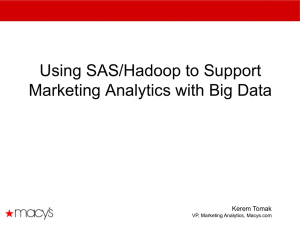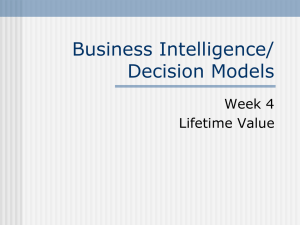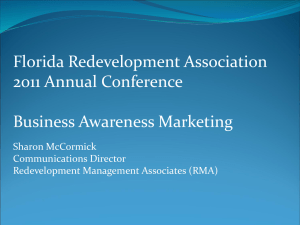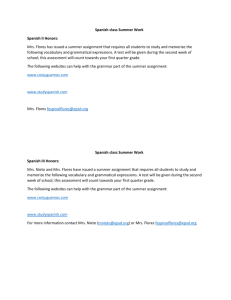Using CLV Concept for Marketing Budgets Allocation
advertisement
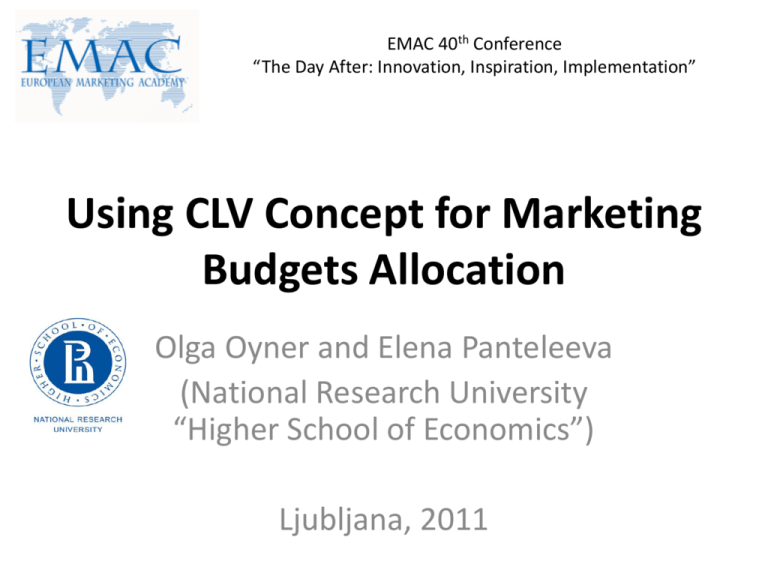
EMAC 40th Conference “The Day After: Innovation, Inspiration, Implementation” Using CLV Concept for Marketing Budgets Allocation Olga Oyner and Elena Panteleeva (National Research University “Higher School of Economics”) Ljubljana, 2011 Theoretical background – To make marketing measurable: • More transparent from financial point of view (Kotler 2002; Kumar2004; Ambler 2006 ) • More efficient in terms of output/input (Shet, Sisodia 2002) • To consider marketing results from long time perspective: from costs to investment and from profit to equity (Rust 2004; Ambler 2006; Strivastava 2001; Doyle 2001) • To estimate marketing impact on financial results and firm value (Rust et al 2004; Ambler 2006; Shet, Sisodia 2002; Srivastava et al 2001) 2 Theoretical background (cont.) • Marketing productivity chain – the marketing impact on the firm’s value (Rust et al 2004; Ambler 2006; Shet, Sisodia 2002; Srivastava et al 2001) • Customer equity and CLV (Pfeifer, Haskins, and Conroy 2004; Rust and Lemon 2001; Rust, Lemon, and Zeithaml 2004; Kumar and Reinartz 2006) 3 Research object • Large multinational business-to-business (B2B) PC hardware manufacturer • Business task: how to generate more value from every client? 4 Model: chain of marketing productivity 5 Aims • The proposed model is aimed at increasing the efficiency of the intrafirm budget allocation because it will help determine which marketing instruments have the greatest impact on CLV and sales • Sales targets are set on individual level and don’t take into account marketing budgets spent on each single customer in order to achieve these results. So we need to find out if there are any differences in how marketing instruments contribute to the sales volumes and CLV 6 Data characteristics • Data on purchase volume and marketing budgets spent on various marketing activities for company’s clients • 451 clients from one of the sub regions of Russia and CIS countries • 1471 datum 7 Hypotheses • H1: discount amount positively influences the sales volume, but doesn’t significantly add to the CLV • H2: account manager (communication level) has positive and the greatest impact on sales • H3: retail promotion has positive impact on sales but this impact is less then account manager has • H4: core product promotion has positive impact on sales but less then all above has • H5: other product promotions has positive impact on sales but less then all above has 8 Variables and CLV • Independent variables for the models were: – – – – Account manager – investments in relationship marketing Retail promotions – budgets for co-marketing with retailers Discount – price reductions given to specific customers EPSD – budgets for co-marketing activities with clients for server products (seminars for end-users, trade-shows) – UPSD – budgets for co-marketing activities with clients for motherboards (seminars for end-users, trade-shows) – DT - budgets for co-marketing activities with clients for core product (seminars for end-users, trade-shows) Sum of SO Amt Disti Cost CLV 13073530 50692756 Discounts Retail promotions Account Manager UPSD EPSD DT 376987 17000 63110 9000 4000 14700 9 Regression equation: sales Unstandardized Coefficients Model 6 B Std. Error -2080,950 2844,633 Account Manager 215,468 8,273 EPSD 594,232 UPSD Standardized Coefficients t Sig. Beta 95% Confidence Interval for B Lower Bound Upper Bound (Constant) -,732 ,465 -7672,915 3511,016 ,764 26,045 ,000 199,205 231,731 19,225 ,719 30,910 ,000 556,440 632,023 -163,746 18,840 -,226 -8,691 ,000 -200,783 -126,709 DT 55,565 8,672 ,117 6,408 ,000 38,518 72,612 Retail promotions -115,572 26,309 -,141 -4,393 ,000 -167,290 -63,854 Discounts 1,548 ,493 ,062 3,142 ,002 ,580 2,517 Sales = -2080,950+215,468*Account manager +594,232*EPSD promo -163,746*UPSD promo +55,565*DT promo - 115,572*retail promo+1,548*discount 10 Regression equation: CLV Unstandardized Coefficients Standardized Coefficients B Std. Error Beta -43336,460 16671,892 Account Manager 1204,753 48,275 EPSD 2261,849 UPSD Model 5 t Sig. 95% Confidence Interval for B Lower Bound Upper Bound (Constant) -2,599 ,010 -76109,750 -10563,170 ,904 24,956 ,000 1109,855 1299,651 111,820 ,579 20,228 ,000 2042,036 2481,662 -775,462 109,376 -,227 -7,090 ,000 -990,472 -560,453 Retail promotions -767,601 144,021 -,199 -5,330 ,000 -1050,714 -484,487 DT 246,695 50,856 ,110 4,851 ,000 146,722 346,667 CLV (for 4 periods) = -43336,460+ 1204,753* Account manager +2261,849**EPSD promo -775,462* UPSD promo -767,601* retail promo + 246,695 DT promo +0*Discount 11 Regression equation: sales (2) (Constant) Unstandardized Coefficients B Std. Error 11311.215 Standardized Coefficients Beta 1320.071137 t Sig. 8.56864 0.000 Account Manager*EPSD 0.247 0.003292838 0.745918229 74.92194 0.000 Account Manager2 0.056 0.001463787 0.845514497 38.16489 0.000 Discounts2 0.000 3.26565E-06 0.180181136 21.12752 0.000 -0.051 0.003019588 -0.19598328 -16.96065 0.000 0.034 0.005672027 0.261310706 6.070955 0.000 -51.218 6.833582779 -0.18154741 -7.495006 0.000 0.109 0.011900425 0.160109682 9.159051 0.000 -0.003 0.000535477 -0.08463594 -5.3837 0.000 -79.975 21.29279383 -0.16802509 -3.755958 0.000 Account Manager*UPSD DT2 Account Manager Retail promotions*DT Discounts*EPSD DT In order to rationalize the budget allocations we need to determine the equation of the non-linear multiple regression: Sales = 11311.215 + 0.247Account Manager*EPSD+0.056 Account Manager2+0* Discounts2+ -0.051Account Manager*UPSD+0.034 DT2-51.218 Account Manager+0.109 12 Retail promotions*DT-0.003 Discounts*EPSD-79.975 DT Budget allocation optimization Current budget allocation Optimized budget allocation Discounts 376987 0 Retail promotions 17000 9634 Account Manager 63110 69000 UPSD 9000 0 EPSD 4000 5000 DT 14700 24176 Company local budget Company overall budget (incl discounts) 107810 107810 484797 107810 -376987 285515711 391037021 105521311 CLV Difference 13 Framework limitations and future research directions • The study is based on one B2B hardware PC company. Similar studies in identical companies are needed to outline general correlations • It would be useful to calculate CLV and customers’ profitability not only on an aggregated level, but on individual ones in order to tailor marketing mix tactics for each customer specifically 14 Framework limitations and future research directions (cont.) • We evaluated only those budgets, that can be attributed to each customer specifically. We didn’t take into account corporate marketing activities, such as PR, ATL, etc. – how will the proportion between those “customer-specific” and “general” budgets influence the CLV? – what if “general” budgets are more efficient on the company level? 15 Framework limitations and future research directions (cont.) • We didn’t take into account competitor’s response to the marketing actions of the company. But for the oligopoly in which the company in study is in, it is vitally important 16 THANK YOU! Q&A 17

